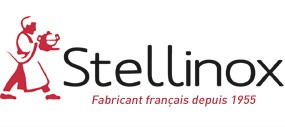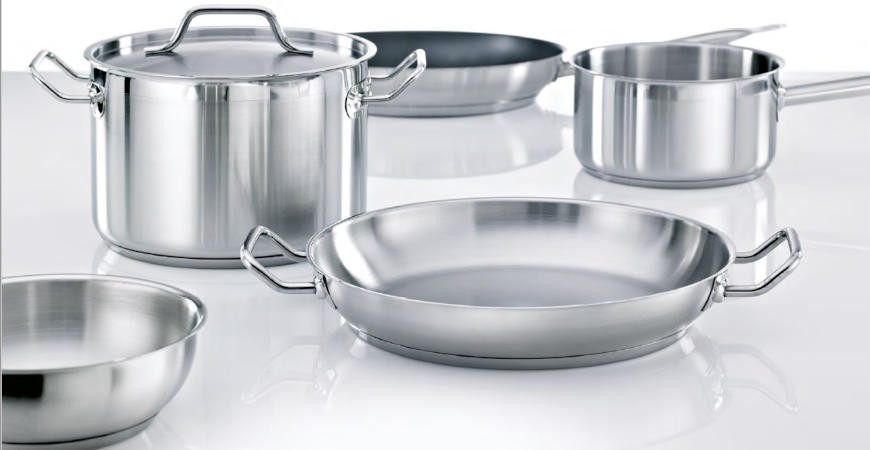Choosing the right stainless steel kitchen equipment
The advantages of stainless steel
Stainless steel is still the most widely used material in the design of equipment for professionals in hotels and the catering industry and, more generally, in all food processing activities, particularly in the professional catering sector. Indeed, its various characteristics give it considerable advantages: durability, solidity, easy cleaning. It is a material without coating, and is therefore totally harmless in food contact, it does not alter the taste, appearance or smell of foods. It is a neutral material, so there is no risk of migration of toxic substances into your food! This is why it is considered a "green product", which means that it is 100% recyclable, and is not coated with any toxic material.
Stainless steel is not only used in equipment and tableware: its smooth, inert surface prevents the growth of bacteria and mould, so it can be found on worktops, in kitchen splash back, stainless steel bowls and sinks, cooktop, etc.
Stainless steel will resist time and corrosion.
Stainless-steel: different grades of stainless steel
The two main grades of stainless steel used for stainless steel equipment and tableware are 18% stainless steel, international standard 430, and 18/10 stainless steel, international standard 304 L.
The difference between these two grades is the nickel content; 18/10 stainless steel contains nickel, which makes it even more rustproof. Its price is higher than 18% stainless steel.
Stainless steel, your best ally in cooking ware
If you decide to choose stainless steel for your cooking ware, look at the thickness of the stainless steel of the equipment: quality equipment will be thicker, up to 2.5 mm on a high-quality pan or saucepan, which helps to produce heat homogeneously. Weight is often an indicator, as it shows you how much stainless steel is used, and the price is often higher. The heavier your pot, pan or saucepan, the more resistant it will be to shock and deformation, and the longer it will last. The "first price" cooking ware is often 0.5 mm thick.
In the Chef range, offered by Stellinox, from GastroSus has wall thickness of up to 1.2 mm.
Suitable for induction ?
In the GastroSus range, the base is encapsulated: stainless steel, aluminium and 18/10 stainless steel. This thick, encapsulated base ensures compatibility with all types of stoves, gas, induction and glass-ceramic. Only the AluStar range is not suitable for induction (all made of aluminium, without encapsulated base).
The Trigon range is entirely made of a combination of three materials, stainless steel, aluminium and 18/10 stainless steel. This range is also suitable for all stoves including induction. In this range, you can choose sauté pan, frying pans with or without non-stick coating, as well as woks.
The Quality Pro range has an energy-efficient, aluminium encapsulated base and is also suitable for all types of stoves.
Stainless steel with non-stick coating?
Make your choice according to the way you are going to cook. The non-stick coating can be preferred if you are cooking delicate dishes, such as fish. The non-stick coating is not suitable for high-temperature cooking; for meat that you want to grill or vegetables that you want to "sauté", this is a high-temperature cooking method: preferably us a full stainless-steel pan.
The different stainless-steel cookware
Shape, height, diameter, you can make specific choices according to your preparations. Do you need to sear, grill or stew? Do you want to prepare a sauce or sauté pancakes?
Don't hesitate to invest in different cooking items: pancake pan, wok, sauté pan, pot... choose the right equipment. Also choose the right size for your preparation, so that you have the right equipment for the quantity of food you want to cook.
Tubular handles and cold handles?
If you want to keep to the concept of quality stainless steel cookware, you also need to look at the type of handle or grip that is offered.
A tubular handle (for a frying pan or saucepot), or so-called cold handles (paella dish, stainless steel lid), will prevent them from heating up during cooking.
As you can see, investing in stainless steel cooking ware, which is more expensive than aluminium or Teflon, will allow you to keep it for a lifetime.
Stainless steel cooking utensils are suitable for all types of cooking. Stainless steel allows you to start cooking at a high heat, then to lower the temperature to continue cooking and stewing, because with stainless steel the heat is homogeneously distributed.
Don't forget that stainless steel is easy to clean and dishwasher proof.
Also choose stainless steel for your kitchen utensils!
Plastic has become more common in our cookware, but it is very controversial, as many plastic materials contain Bisphenol A (BPA), which is known to be an endocrine disruptor and even a carcinogen. Although it is compatible with microwaves, it is not recommended to heat food in plastic containers or to use plastic utensils to stir heated food...
Wooden utensils, a healthy and less harmful material, are pleasant to use. Made from renewable forests, they are environmentally friendly, but they need to be washed and wiped down carefully, as they can be a hotbed for bacteria.
Stainless steel will be your best ally for everyday cooking! Even if it is often more expensive than other materials, for all the arguments we have mentioned (durability, ecological, 100% recyclable), it will allow you to cook with professional quality kitchen accessories, and you will keep them for a long time...

